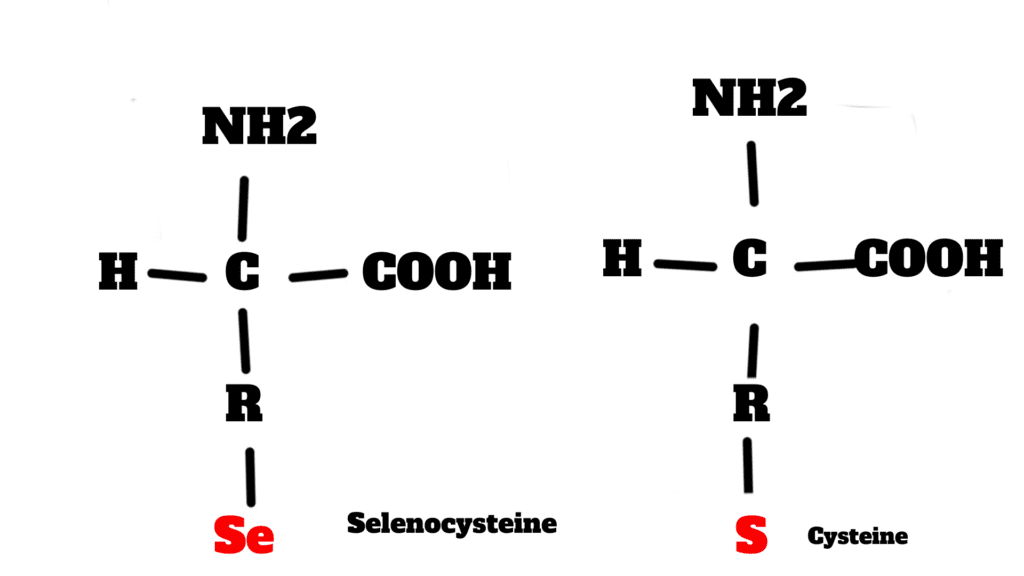Glutathione Peroxidase 4 (GPX4) is a selenoprotein and requires selenium for its structural and functional viability. Selenium (Se) is a trace element in the human body and contributes to the formation of selenoproteins. It was discovered in 1817 with atomic number 34. Selenium, as a dietary source, can be obtained from nuts, grains, legumes, seeds, etc. The body utilizes selenium by incorporating it into proteins, resulting in selenoproteins.
What are Selenoproteins?
Selenoproteins are named so because they contain selenium in the form of selenocysteine. Selenocysteine is an amino acid, that contains selenium instead of sulfur in the cysteine’s structure. Cysteine is also an amino acid that contains sulfur in its side chain . Selenocysteine is located at specific positions in selenoproteins within amino acid chains. The accurate localization of selenocysteine is crucial for apposite Selenoprotein activity. Selenoproteins are diverse and may perform many imperative operations inside the human body. They are responsible for the conversion of thyroid hormone T4 into its more active form T3.

They support immune health and have a hand in DNA synthesis or repair. Selenoproteins are famously known for their marvelous antioxidant properties. They conserve the rapidly growing cells and DNA from oxidative stress from unstable biological species.
Glutathione Peroxidase 4 (GPX4) as an Antioxidant
Antioxidants combat oxidative stress by stabilizing the reactive species. Oxidative stress occurs when there is a lack of stable molecules that have the potential to remove or compensate for reactive molecules.
Reactive molecules such as free radicals have unpaired electrons in their outermost shells. Antioxidants stabilize them by donating an electron to fill the missing place. Antioxidants can donate electrons without becoming reactive ones. Another way antioxidants benefit the cellular environment is to limit the synthesis of free radicals. Antioxidants can chelate the metals that catalyze the production of free radicals. Reactive Oxygen Species (ROS) are also unstable molecules that can elicit oxidative stress. Antioxidants stabilize the ROS like hydrogen peroxide by reducing them into harmless, stable molecules.
Glutathione Peroxidase 4 (GPX4), a selenoprotein, contains selenium at its active site in the form of selenocysteine. It is a powerful antioxidant that lessens the oxidative stress on developing cells.
How Does Glutathione Peroxidase 4 (GPX4) Protect Developing Sperms Cells?
GPX4 does not only influence sperm cells but the overall body. GPX4 emphasize on developing sperm cells and reflects the fact that developing sperm cells are more vulnerable to oxidative stress. Developing or rapidly growing cells are liable to be attacked by reactive oxygen species (ROS). Rapidly growing cells have a high metabolic rate and heighten the production of ROS as a by-product during biochemical reactions. Rapidly growing cells, such as in embryonic development or any cellular division, require elevated energy sources.
Mitochondria, the energy-production house of the human body increases in number and cellular activity. Mitochondria produces energy in the form of ATP by cellular respiration. Cellular respiration within mitochondria results in the production of ROS.
Similarly, developing sperm cells are at a greater risk of oxidative stress. Moreover, sperm cells have polyunsaturated fatty acids in their cell membrane. They are prone to lipid peroxidation. GPX4 reduces the peroxidases into harmless water molecules. Developing sperm cells that have incomplete cellular structures are not fully capable of combatting reactive oxygen species. GPX4 from nuts or legumes are not only beneficial foods for male reproductive health, many other foods support the conformational integrity of male reproductive system. Major examples of other such foods are omega-3 fatty acids. Read such more foods for reproductive stability.
Glutathione Peroxidase (GPX4) Protects Sperm Lipid Membranes
The basic integrity of sperm lies in its lipid cell membrane maintenance. Lipid cell membranes of sperms have very important roles to perform. In fact, these cell membranes are most active in the process of sperm development and fertilization. GPX4 cares for sperm cells by protecting these cell membranes from ROS. As explained above, the most vulnerable targets of ROS are the developing or high metabolic sites. When sperms are in the stage of development, their cell membranes are exposed to these reactive molecules. Most of them are synthesized as by-products during metabolic activities.
ROS, including superoxides and peroxides, target the phospholipid membranes of cells and most specifically target the double-bond positions. For more simplicity, phospholipids are the key figure in cell membranes which contain double bonds. ROS affects these double bonds and makes them very reactive lipid peroxyl radicals. These radicals further target neighboring phospholipid structures and result in more emergence of lipid peroxyl radicals.
As a result, it may cause damage to the whole lipid membrane and successively impair the functional ability of male reproductive players and sperm. Lipid membranes are very crucial for sperm motility and their movements inside the female body. GPX4 avoids lipid peroxidation of sperm membranes by neutralizing ROS. GPX4 prevents ROS from attacking the developing sperm due to their anti-oxidizing functions.
Summary
Ergo, selenoproteins play an invaluable role in the protection of developing sperm cells in the testis. Sperm cells are the core of men’s reproductive health and need to be robust for inducing fertility. So, it is necessary to add selenium into daily routine in the form of a balanced diet. Too much or too little selenium can have negative effects on the antioxidizing properties of the body.




